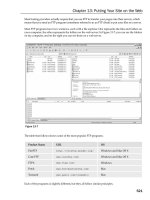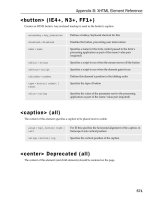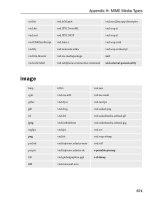Tài liệu Network Programming with Perl pdf
Bạn đang xem bản rút gọn của tài liệu. Xem và tải ngay bản đầy đủ của tài liệu tại đây (301.24 KB, 79 trang )
;-_=_Scrolldown to the Underground_=_-;
Network Programming
/>Network
Programming
with
Perl
Graham Barr
<>
Slide 2
Agenda
Introduction
Properties of a socket
The socket model
TCP server/client
examples
Using UDP
UDP server/client
examples
IO::Socket, with
examples
☞
☞
☞
☞
☞
☞
☞
Find information about
a socket
Types of server
Common problems
Commonly used
network protocols
Case studies
☞
☞
☞
☞
☞
Slide 3
Introduction
Perl provides direct access to the C library routines for
socket communication. Often, arguments and return
values are constants defined in the C header files, or
are data structures which Perl will pass in a packed
binary format.
The Socket module provides these constants and also
many functions for packing and unpacking these data
structures
The IO::Socket module provides a higher level access
to creating a socket
CPAN contains many modules that provide a very high
level access to specific application protocols. e.g.
Net::FTP, Net::SMTP, Net::DNS, etc.
☞
☞
☞
☞
Slide 4
Socket properties
A generic socket has three properties
A type
An address family
A communication protocol
☞
Ä
Ä
Ä
Slide 5
Socket types
There are many types of socket, these include
Stream - Connection oriented transport
Datagram - Connection-less transport
Raw - Often used to talk directly to the IP layer. For
example, ping uses a raw socket to send ICMP
packets
The system socket functions use numbers to represent
these. The Socket module exports constants for these
use Socket qw(SOCK_STREAM SOCK_DGRAM SOCK_RAW);
☞
Ä
Ä
Ä
☞
Slide 6
Address families
Available address families include
AF_UNIX - Communication is limited to a single
machine. Sometimes called AF_LOCAL or AF_FILE.
The address is a filesystem path on the local
machine.
AF_INET - This address family uses the IP protocol
to communicate with other machines over a network.
The address is 193.168.1.200/21
Others include AF_APPLETALK, AF_IPX,
AF_DECnet ...
These are represented as numbers and the Socket
module exports constants for these
use Socket qw(AF_UNIX AF_INET AF_APPLETALK);
☞
Ä
Ä
Ä
☞
Slide 7
Communication protocols
There are two protocols that are mainly used
TCP is used with a stream socket to provide a
reliable, sequenced, flow-controlled channel of
communication.
UDP is used with a datagram socket and delivers
datagrams to other endpoints. Message boundaries
are preserved, but sequence is not and delivery is
not guaranteed.
Protocols are represented as numbers, but are not
available as constants. Perl provides some functions for
translating protocol names to numbers and visa-versa.
$number = getprotobyname( ’tcp’ );
$name = getprotobynumber( 6 );
☞
Ä
Ä
☞
Slide 8
The socket model
The Server
Creates a generic socket with socket
Binds to a known address with bind
Tell system to watch for incoming connections with
listen
Waits for a connection with accept or select
☞
Ä
Ä
Ä
Ä
Slide 9
The socket model (cont.)
The client
Creates generic socket with socket
Binds to an address with bind
Connects to server with connect, using the known
address. This establishes the connection.
☞
Ä
Ä
Ä
Slide 10
The socket model (cont.)
The server is notified of the new connection.
Either accept returns or select will report the
socket as readable.
Server and Client communicate.
Server and Client close the socket to break the
connection.
☞
Ä
☞
☞
Slide 11
Creating a socket
To create a socket you need to know all three
properties about the socket.
import required constants from the Socket module
use Socket qw(AF_INET SOCK_STREAM);
Obtain the value for the protocol
$proto = getprotobyname(’tcp’);
Create the socket
socket(SOCK, AF_INET, SOCK_STREAM, $proto)
|| die "socket: $!";
☞
Ä
Ä
Ä
Slide 12
Binding the socket
bind takes two arguments, the first is the socket and
the second is a packed address.
The Socket module provides functions for packing and
unpacking addresses.
sockaddr_in allows you to either pack or unpack an
AF_INET socket address. In a scalar context it packs
and in a list context it will unpack.
$paddr = sockaddr_in($port, $inaddr);
($port, $inaddr) = sockaddr_in($paddr);
If the use of context here disturbs you then you can
explicitly call pack_sockaddr_in and
unpack_sockaddr_in.
☞
☞
☞
☞
Slide 13
Binding the socket (cont.)
Many protocols, for example FTP and Telnet, use well
known port numbers. But, like communication protocols,
these are not provided by constants but by lookup
routines
$port = getservbyname(’ftp’,’tcp’);
$service = getservbyport(21, ’tcp’);
($name, $aliases, $port, $proto)
= getservbyname(’ftp’, ’tcp’);
($name, $aliases, $port, $proto)
= getservbyport(21, ’tcp’);
If you do not care which port the socket is bound to, you
can use 0 and the kernel will select a free port number.
☞
☞
Slide 14
Binding the socket (cont.)
Besides the port, sockaddr_in also needs an IP
address.
If you do not want to bind the socket to a particular
interface the you can use INADDR_ANY.
If you want to bind the socket to a particular interface
then you must pass a packed IP address.
The Socket module provides inet_aton and
inet_ntoa to pack and unpack IP addresses.
$ipaddr = inet_aton("localhost");
$quad = inet_ntoa($ipaddr);
Not calling bind is treated the same as calling bind
with a port of 0 and INADDR_ANY. This is not normally
useful for a server.
☞
☞
☞
☞
☞
Slide 15
Binding the socket (cont.)
If the socket is of type AF_UNIX the the socket
addresses can be manipulated with sockaddr_un,
pack_sockaddr_un and unpack_sockaddr_un.
$paddr = sockaddr_un("/tmp/sock");
($path) = sockaddr_un($paddr);
☞
Slide 16
Listen for connections
On the server side you must tell the system that you
want to wait for incoming connections. This is done with
the listen function
listen(SOCK, 10);
The second argument is the queue size.
SOMAXCONN, which is exported by Socket, is the
maximum value your system will accept.
On most systems, passing a value of 0 will cause
the value SOMAXCONN to be used.
On most systems, passing a value greater than
SOMAXCONN will silently be ignored and the value of
SOMAXCONN will be used.
☞
Ä
Ä
Ä
Ä
Slide 17
The client side
Creating a socket on the client side is similar.
$proto = getprotobyname(’tcp’);
socket(SOCK, AF_INET, SOCK_STREAM, $proto)
or die "socket: $!";
Some servers may require a client to bind to a particular
port. Some require use of a port number less than
1024, which on UNIX can only be performed by root.
$sin = sockaddr_in($port, INADDR_ANY);
bind(SOCK, $sin) or die "bind: $!";
As with the server side, if bind is not called, the kernel
will select a port number when connect is called. The
address will be the address of the interface used to
route to the server.
☞
☞
☞
Slide 18
Connecting to the server
Once a socket has been created on the client it must
connect to the server at the known address.
connect takes two arguments, the socket and a
packed socket address for the port on the remote host
to connect to
$port = getservbyname(’daytime’,’tcp’);
$inaddr = inet_aton(’localhost’);
$paddr = sockaddr_in($port, $inaddr);
connect(SOCK, $paddr) or die "connect: $!";
☞
☞
Slide 19
Connecting to the server (cont.)
connect has a built-in timeout value before it will return
a failure.
On many systems this timeout can be very long.
One approach to shorten this time is to use an alarm.
eval {
local $SIG{ALRM} = sub { die "Timeout" };
alarm 20; # a 20 second timeout
my $val = connect(SOCK, $paddr);
alarm 0;
$val;
} or die "connect: $!";
Another approach is to use non-blocking IO.
☞
☞
☞
☞
Slide 20
Accepting a client connection
When a client calls connect, the server will be notified
and can then accept the connection.
$peer = accept(CLIENT, SOCK);
This will create a perl filehandle CLIENT which can be
used to communicate with the client.
$peer will be a packed address of the client's port, and
can be unpacked with
($port,$inaddr) = sockaddr_in($peer);
$dotted_quad = inet_ntoa($inaddr);
☞
☞
☞
Slide 21
example protocols
The daytime protocol is used to keep the time on two
machines in sync.
When the server gets a request from a client, it
responds with a string which represents the date on
the server.
The echo protocol can be used to indicate that a
machine is up and running. It can also be used to check
the quality of the network.
When the server receives anything, it responds by
sending it back where it came from.
☞
Ä
☞
Ä
Slide 22
#!/bin/perl -w
# Example of a TCP daytime client using perl calls directly
use Socket qw(AF_INET SOCK_STREAM inet_aton sockaddr_in);
# get protocol number
$proto = getprotobyname(’tcp’);
# create the generic socket
socket(SOCK, AF_INET, SOCK_STREAM, $proto) or die "socket: $!";
# no need for bind here
# get packed address for host
$addr = inet_aton(’localhost’);
# get port number for the daytime protocol
$port = getservbyname(’daytime’, ’tcp’);
# pack the address structure for connect
$paddr = sockaddr_in($port, $addr);
TCP daytime client
Slide 23
# connect to host
connect(SOCK, $paddr) or die "connect: $!";
# get and print the date
print <SOCK>;
# close the socket
close(SOCK) || die "close: $!";
TCP daytime client (cont.)
Slide 24
#!/bin/perl -w
# Example of a daytime TCP server using perl functions
use Socket qw(INADDR_ANY AF_INET SOMAXCONN SOCK_STREAM sockaddr_in);
# Get protocol number
my $proto = getprotobyname(’tcp’);
# Create generic socket
socket(SOCK, AF_INET, SOCK_STREAM, $proto) or die "socket: $!";
# Bind to the daytime port on any interface
my $port = getservbyname(’daytime’,’tcp’);
my $paddr = sockaddr_in($port, INADDR_ANY);
bind(SOCK, $paddr) or die "bind: $!";
# Notify the kernel we want to accept connections
listen(SOCK, SOMAXCONN) or die "listen: $!";
while(1) {
if(accept(CLIENT, SOCK)) {
print CLIENT scalar localtime, "\n";
close CLIENT;
}
}
TCP daytime server









